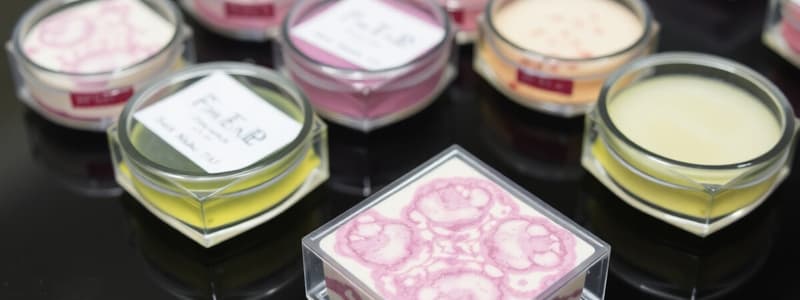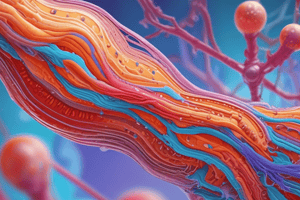Podcast
Questions and Answers
What is the ideal location for fixation of a specimen after dissection?
What is the ideal location for fixation of a specimen after dissection?
- At the site of removal (correct)
- In a transport container
- In a storage facility
- In a laboratory setting
What should be done with specimens after dissection to ensure their integrity?
What should be done with specimens after dissection to ensure their integrity?
- They should be fixed as soon as possible (correct)
- They should be left out for observation
- They can be stored at room temperature
- They must be handled carelessly to avoid damage
What is a critical step after specimen dissection?
What is a critical step after specimen dissection?
- Transporting the specimen to a distant location
- Fixation of the specimen should be delayed
- Handling the specimen with care (correct)
- Immediate disposal of the specimen
Why is it important to fix specimens promptly?
Why is it important to fix specimens promptly?
What can occur if fixation is not properly handled after dissection?
What can occur if fixation is not properly handled after dissection?
What is a crucial requirement for reagents used in fixation?
What is a crucial requirement for reagents used in fixation?
What is the primary purpose of using a liquid fixing agent like formaldehyde solution?
What is the primary purpose of using a liquid fixing agent like formaldehyde solution?
Why is it important for tissue components to retain chemical reactivity during fixation?
Why is it important for tissue components to retain chemical reactivity during fixation?
Which of the following best describes how formaldehyde solution interacts with tissue?
Which of the following best describes how formaldehyde solution interacts with tissue?
Which of the following can be considered unsuitable for fixation due to its properties?
Which of the following can be considered unsuitable for fixation due to its properties?
What is a characteristic that fixation reagents must possess?
What is a characteristic that fixation reagents must possess?
What happens to tissue after it is treated with a liquid fixing agent?
What happens to tissue after it is treated with a liquid fixing agent?
Which property of fixation reagents can directly impact staining results?
Which property of fixation reagents can directly impact staining results?
Which step occurs immediately after applying a fixative like formaldehyde to tissue?
Which step occurs immediately after applying a fixative like formaldehyde to tissue?
Why is it important for a fixative to protect tissue during subsequent processing steps?
Why is it important for a fixative to protect tissue during subsequent processing steps?
What is the primary purpose of using formalin in tissue preservation?
What is the primary purpose of using formalin in tissue preservation?
In what form is formalin typically used for tissue fixation?
In what form is formalin typically used for tissue fixation?
How long should specimens ideally remain in fixative?
How long should specimens ideally remain in fixative?
What is one key characteristic of tissues that have been fixed in formalin?
What is one key characteristic of tissues that have been fixed in formalin?
What should not be expected from specimens submerged in formalin?
What should not be expected from specimens submerged in formalin?
What is the primary purpose of substituting water with alcohol in the dehydration process?
What is the primary purpose of substituting water with alcohol in the dehydration process?
What is the correct concentration of ethanol used in the first step of the dehydration sequence for specimens up to 4mm thick?
What is the correct concentration of ethanol used in the first step of the dehydration sequence for specimens up to 4mm thick?
How long should a specimen be immersed in 100% ethanol during the dehydration process according to the typical sequence?
How long should a specimen be immersed in 100% ethanol during the dehydration process according to the typical sequence?
What is the order of the ethanol concentrations in the dehydration sequence for specimens not more than 4mm thick?
What is the order of the ethanol concentrations in the dehydration sequence for specimens not more than 4mm thick?
Which concentration of ethanol is used for the second step in the dehydration process?
Which concentration of ethanol is used for the second step in the dehydration process?
What is the outcome after using ethanol for 45 minutes at 100% concentration?
What is the outcome after using ethanol for 45 minutes at 100% concentration?
How long should ethanol be applied to effectively remove tightly bound water?
How long should ethanol be applied to effectively remove tightly bound water?
What concentration of ethanol was used for the removal of tightly bound molecular water?
What concentration of ethanol was used for the removal of tightly bound molecular water?
After using ethanol for 30 minutes, what state is the remaining water in the specimen?
After using ethanol for 30 minutes, what state is the remaining water in the specimen?
What should be expected after treating a specimen with ethanol for a prolonged period?
What should be expected after treating a specimen with ethanol for a prolonged period?
Flashcards
Specimen Fixation
Specimen Fixation
The process of preserving a biological specimen to prevent decay or decomposition.
Ideal Fixation Site
Ideal Fixation Site
The best location for fixing a specimen is at the point of removal, such as an operating room.
Specimen Handling
Specimen Handling
Careful treatment of the biological specimen to maintain its integrity.
Timely Fixation
Timely Fixation
Signup and view all the flashcards
Tissue Fixation
Tissue Fixation
Signup and view all the flashcards
Limited Fixation Reagents
Limited Fixation Reagents
Signup and view all the flashcards
Tissue Reactivity
Tissue Reactivity
Signup and view all the flashcards
Fixative
Fixative
Signup and view all the flashcards
Fixation
Fixation
Signup and view all the flashcards
Formalin
Formalin
Signup and view all the flashcards
Chemical Changes
Chemical Changes
Signup and view all the flashcards
Staining Techniques
Staining Techniques
Signup and view all the flashcards
Physical Changes
Physical Changes
Signup and view all the flashcards
Formalin fixative
Formalin fixative
Signup and view all the flashcards
Paraffin sections
Paraffin sections
Signup and view all the flashcards
Tissue preservation
Tissue preservation
Signup and view all the flashcards
Fixative solution
Fixative solution
Signup and view all the flashcards
Phosphate-buffered formalin
Phosphate-buffered formalin
Signup and view all the flashcards
Specimen
Specimen
Signup and view all the flashcards
Ethanol Treatment (30 min)
Ethanol Treatment (30 min)
Signup and view all the flashcards
Ethanol Treatment (45 min)
Ethanol Treatment (45 min)
Signup and view all the flashcards
Removing Water Residue
Removing Water Residue
Signup and view all the flashcards
Specimen Dehydration
Specimen Dehydration
Signup and view all the flashcards
Dehydration Sequence (4mm)
Dehydration Sequence (4mm)
Signup and view all the flashcards
Ethanol Percentage
Ethanol Percentage
Signup and view all the flashcards
Ethanol Duration
Ethanol Duration
Signup and view all the flashcards
Specimen Thickness
Specimen Thickness
Signup and view all the flashcards
Study Notes
Histotechnology: Fixation and Dehydration
- Specimen Acquisition: Fresh tissue specimens originate from various sources. They can be easily damaged during removal, so careful handling and prompt fixation are crucial. Ideal fixation occurs at the site of removal (e.g., operating theater) or immediately following.
Fixation
-
Purpose: Tissue specimens are placed in a liquid fixing agent (fixative) like formalin to cause chemical and physical changes hardening and preserving the tissue, protecting it from subsequent processing.
-
Fixative Selection: Only a limited number of reagents can be used for fixation, because the fixative must possess specific properties to be suitable. These properties ensure tissue preservation and chemical reactivity for subsequent staining procedures.
-
Formalin: Formalin (a phosphate-buffered solution) is the most commonly used fixative for paraffin sections.
-
Fixation Time: Specimens typically require between 6 to 24 hours of fixation to allow the fixative to penetrate all tissue components, and the chemical reactions to reach equilibrium.
Dehydration
-
Purpose: Melted paraffin wax is hydrophobic (water-resistant), so any water present must be removed from the specimen before infiltration with wax.
-
Method: Dehydration is commonly achieved by immersing the specimen in a series of increasing concentrations of ethanol (alcohol) solutions until pure, water-free alcohol is reached.
-
Ethanol's Properties: Ethanol is miscible with water. This ensures the water in the specimen is replaced progressively by the alcohol.
-
Dehydration Sequence: A common dehydration sequence for specimens not exceeding 4mm thick involves specific ethanol concentrations and time durations (e.g., 15 minutes in 70% ethanol, 90%, and later stages at 100% with increasing durations). This process aims to remove almost all of the water from the specimen.
Studying That Suits You
Use AI to generate personalized quizzes and flashcards to suit your learning preferences.




